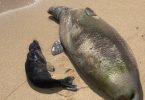At one beach in Spain, increasing numbers of tourists have caused a 60 percent decline in shell abundance, potentially disrupting the aquatic ecosystem.
alking along the seashore in search of shells and other curios is a favorite pastime for beachgoers of all ages. When those whimsical walkers pocket the nautical treasures they find on the beach, however, there can be unintended environmental repercussions. Shells provide a diverse swath of environmental functions: they help to stabilize beaches and anchor seagrass; they provide homes for creatures such as hermit crabs and hiding places for small fish; they are used by shorebirds to build nests; and when they break down, they provide nutrients for the organisms living in the sand or for thsoe that build their own shells.
According to new research published in PLoS One, seemingly innocent shell collecting may be having an impact on these environmental functions. As tourism increases at a beach, researchers found, the number of shells found there, in turn, decreases. This might lead to a decline in beach health. This study did not explore those potential detrimental environmental impacts caused by missing shells, but the authors think the habitat changes might be “multiple,” including increased beach erosion, a decline in calcium carbonate from recycled shells and a drop in diversity and abundance of animals and plants that depend on shells, such as crabs, small fishes, algae and seagrass.






















